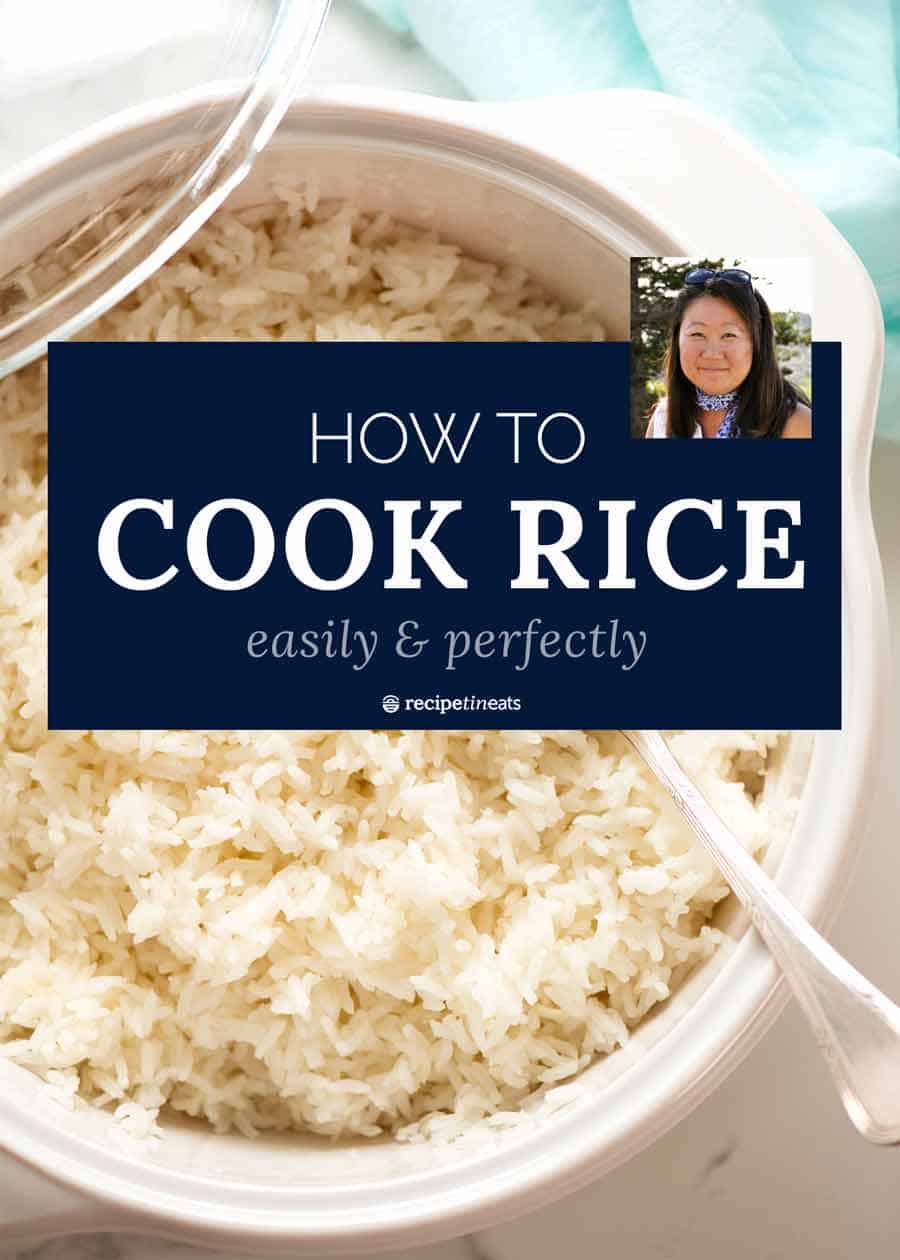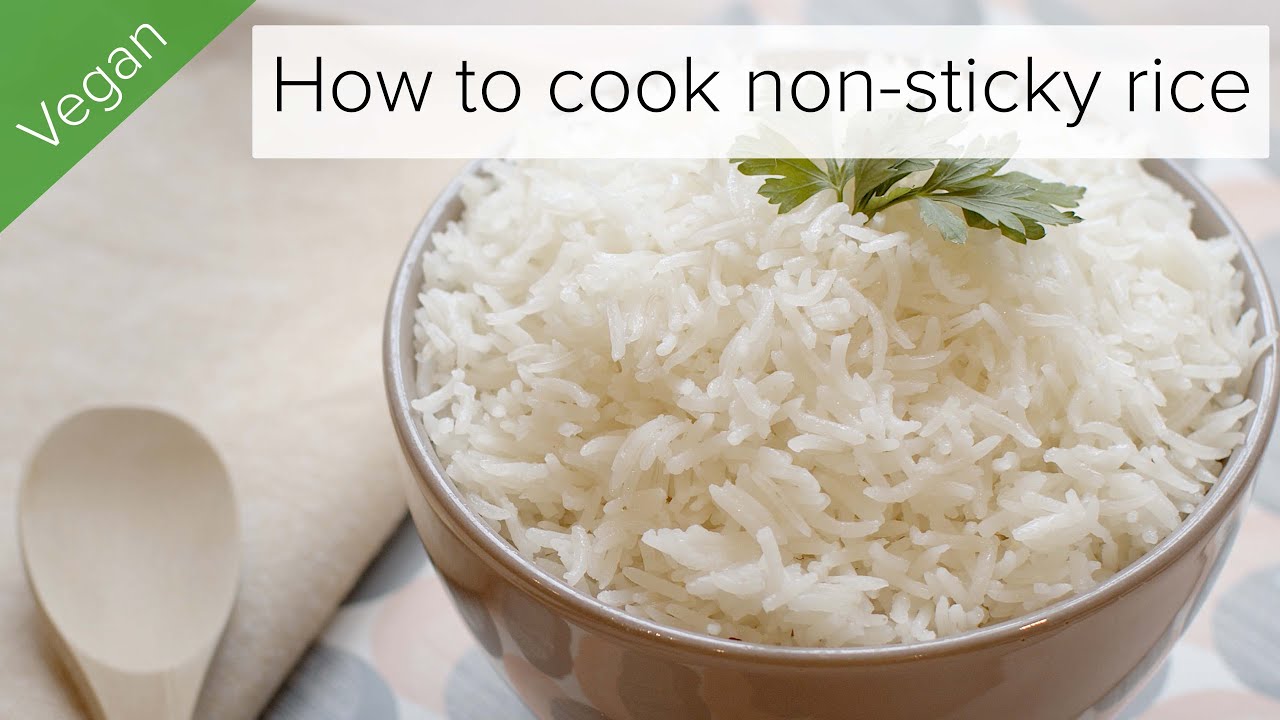To make rice less sticky, rinse it before cooking and use a slightly lower water-to-rice ratio. This will help remove excess starch and prevent the grains from clumping together.
Making rice less sticky is a common challenge faced by many home cooks. Sticky rice can be unappealing and difficult to work with, especially when trying to create separate, fluffy grains. However, by following a few simple steps, you can achieve perfectly cooked, non-sticky rice every time.
Whether you prefer long-grain, basmati, or jasmine rice, these techniques can be applied to any variety. With the proper preparation and cooking method, you can enjoy light and fluffy rice in all your favorite dishes. Let’s explore some effective ways to make rice less sticky without compromising on flavor or texture.

Credit: www.recipetineats.com
Perfect Fluffy Rice: Less Sticky Secrets
When cooking rice, it’s important to know that the starch is what makes it sticky. Washing the rice before cooking can remove excess starch, leading to less sticky results. Using the correct water-to-rice ratio and allowing the rice to rest after cooking can also contribute to a lighter, fluffier texture. Additionally, choosing the right type of rice can make a significant difference in the stickiness of the final product. For instance, long-grain rice tends to be less sticky than short-grain varieties. Making small adjustments to your cooking method and ingredients can lead to a perfect, less sticky batch of rice every time.
Choosing The Right Rice
| Rice Type | Stickiness Level |
|---|---|
| Basmati | Low |
| Jasmine | Medium |
| Long Grain White | Low |
When making rice less sticky, the type of rice you choose is crucial. Basmati rice and long-grain white rice are excellent options for achieving fluffy results. They both have low stickiness levels compared to medium-grain varieties such as jasmine rice. By selecting the right rice type, you can significantly impact the texture of the cooked rice.
Pre-cooking Tips For Non-sticky Rice
Rice Less Stickiness Tips: Before cooking rice, it’s crucial to rinse rice thoroughly under cold water to remove excess starch. This helps prevent the rice from becoming sticky while cooking. Soaking rice for 30 minutes to 1 hour can also contribute to making it less sticky by allowing the grains to absorb water evenly. Ensuring the right water-to-rice ratio is critical – using too much water can lead to sticky rice, while too little can result in undercooked grains.
Cooking Techniques For Fluffy Rice
Boiling rice for non-stickiness: To make rice less sticky, rinse it thoroughly before cooking to remove excess starch. Use a 1:1.5 or 1:2 ratio of rice to water, and bring it to a boil. Once boiling, reduce the heat to low and cover the pot to let it simmer for about 18-20 minutes. Fluff the rice with a fork after cooking to prevent it from becoming sticky.
Steaming versus boiling: Steaming rice can also result in fluffy, non-sticky rice. This method involves placing the rice in a pot with a steamer basket over boiling water and covering it with a lid. Allow the rice to steam for about 20 minutes, then fluff it with a fork to achieve a non-sticky texture.
The low-heat simmer method: Cooking rice on low heat prevents it from becoming sticky. After bringing the rice to a boil, reduce the heat to the lowest setting and let it cook for the recommended time. This gentle cooking process helps to yield perfectly fluffy, non-sticky rice every time.
Mistakes To Avoid When Cooking Rice
When cooking rice, it is important to avoid over-stirring as this can lead to a sticky texture. Additionally, misjudging cooking times and water amounts can also contribute to the stickiness of the rice. It is crucial to follow the correct water-to-rice ratio and cooking times to achieve perfectly fluffy and non-sticky rice. By avoiding these common pitfalls, you can ensure that your rice turns out light and separated, making it a delicious addition to any meal.
Post-cooking Tricks For Perfect Rice
When making rice, it is crucial to let it rest after cooking to improve texture. Fluffing the rice with a fork rather than stirring it can help prevent stickiness and create lighter, fluffier grains. Additionally, using a rice cooker with precise temperature control can greatly impact the final texture of the rice, resulting in perfectly cooked grains with ideal consistency. Ensuring the proper resting time, using the right fluffing technique, and utilizing a high-quality rice cooker can collectively contribute to achieving less sticky and more enjoyable rice.
Storage And Reheating: Maintaining Fluffiness
When storing cooked rice, it’s important to transfer it to an airtight container and refrigerate it within two hours of cooking. Ensure that the rice has cooled to room temperature before refrigerating to prevent condensation. When reheating rice for a non-sticky texture, consider adding a tablespoon of water per cup of rice and reheating it in the microwave. Freezing rice can help maintain its integrity, but it’s important to seal it in an airtight container or freezer bag to prevent freezer burn. When ready to use, allow the frozen rice to thaw in the refrigerator overnight before reheating. By following these best practices for storage and reheating, you can help maintain the fluffiness of your rice and make it less sticky.
Expert Advice: Chef’s Hacks
Adding a small amount of oil or butter to the cooking water can help prevent the rice from sticking together. This method adds extra flavor and helps the grains to cook more independently. When dealing with altitude or humidity, adjusting the cooking time or the amount of water used can make a significant difference. Rice varieties and specific cooking techniques also play a crucial role in achieving the desired consistency. Taking into account these factors can lead to perfectly cooked, non-sticky rice every time.
Troubleshooting Sticky Rice Situations
Encountering sticky rice? Try these methods to make it less sticky. Rinse the rice, use the correct water ratio, and avoid overcooking. These simple steps can help improve the texture and consistency of your rice.
| Quick Fixes for Sticky Rice: | Rinse the rice thoroughly before cooking to remove excess starch that leads to stickiness. Use the right ratio of water to rice – typically 1:1 for long-grain white rice. Add a splash of vinegar or lemon juice to the cooking water to help loosen the starch and prevent clumping. |
| How to Repurpose Overcooked Rice: | Transform overcooked rice into savory rice pancakes or rice pudding. Mix it into soups, stews, or casseroles to absorb excess moisture and add texture. Consider using it in rice-based salads or fried rice for a quick and tasty meal. |
| Learning from Common Rice Cooking Errors: | Avoid stirring the rice while it’s cooking to prevent excess starch release and stickiness. Use the appropriate heat setting – simmer the rice gently rather than boiling vigorously. Allow the rice to steam off the heat after cooking to achieve a light, fluffy texture. |
Frequently Asked Questions For How To Make Rice Less Sticky
How Can I Prevent Rice From Being Sticky?
To prevent sticky rice, rinse it before cooking and use the right ratio of water.
What Are The Best Types Of Rice For Less Stickiness?
Opt for long-grain rice or basmati rice to achieve less stickiness.
How Does Soaking Rice Affect Stickiness?
Soaking rice for 30 minutes can reduce stickiness by removing excess surface starch.
Can Adding Oil Or Vinegar Reduce Rice Stickiness?
Yes, adding a few drops of oil or vinegar can help prevent the rice from becoming sticky.
Does The Cooking Time Affect Rice Stickiness?
Cooking rice for the correct duration as per the type can help in reducing stickiness.
Conclusion
There are several ways to make rice less sticky. By rinsing the rice before cooking, using the right ratio of water, and allowing the rice to rest after cooking, you can achieve perfect, non-sticky rice. Experiment with different methods to find the one that works best for you.
With these tips, you’ll be able to enjoy fluffy, separate grains of rice in no time.
